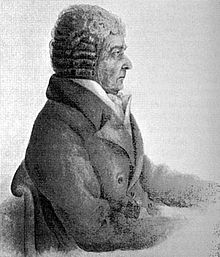John Latham (ornithologist)
John Latham (born June 27, 1740 in Eltham , † February 4, 1837 in Winchester ) was a British doctor , ornithologist , naturalist and author .
Live and act
Latham practiced as a doctor in Dartford in the English county of Kent , where he prepared the Provence warbler ( Sylvia undata ) . He went in 1796 to the retired and moved to Hampshire .
His most famous works are: A general synopsis of birds (1781–1801) and A general history of birds (1821–28). A general synopsis of birds was also Latham's first ornithological work and contained 106 illustrations drawn by him. It described many new species that he discovered in various museums and collections. Like Leclerc de Buffon (1707–1788), he paid no attention to the nomenclature of these species. Later, however, Latham noticed that only the binomial nomenclature, as used by Carl von Linné (1707–1778), would earn him the respect necessary to recognize these species as well as determined by him. So in 1790 he published the index ornithologicus , in which he gave every bird species he has described a binomial name. Unfortunately, Johann Friedrich Gmelin (1748–1804) was faster and gave these species a scientific name in his own version of Linné's Systema Naturæ .
Latham owned one of the largest private bird collections of his time, which devoured his fortune. It was auctioned off piece by piece, the auction lasted over a year, and representatives of the major museums in Europe were also present, so that pieces from his collection can be found in numerous museums. The auction catalog is an important source of ornithology at the time.
Latham became known as "the grandfather of Australian ornithology ". He studied Australian birds that arrived in England in the last quarter of the 18th century . Until then, he gave unnamed birds scientific names. Among them were the emu ( Dromaius novaehollandiae ), the white- hooded cockatoo ( Cacatua alba ), the wedge-tailed eagle ( Aquila audax ), the gray-backed celibate ( Menura novaehollandiae ) and the Australian flute bird ( Gymnorhina tibicen ). He was also the first to describe the hyacinth macaw ( Anodorhynchus hyacinthinus ).
Latham was elected to the Royal Society in 1775 and was a co-founder of the Linnean Society of London . In 1794 he was elected a member of the German Academy of Sciences Leopoldina .
Works
-
A general synopsis of birds. 3 volumes and 2 supplements. White / Leigh & Sotheby, London 1781–1802.
- General overview of the birds. 7 volumes. Translated from English, with comments and additions by Johann Matthäus Bechstein . Weigel, Nuremberg 1792–1811.
- Index ornithologicus, sive systema ornithologiae, complectens avium divisionem in classes, ordines, genera, species, ipsarumque varietates. 2 volumes. Leigh et Sotheby, London 1790.
- Faunula Indica id est Catalogus animalium Indiae orientalis. Gebauer, Halle 1795.
- A general history of birds. 10 volumes. Jacob & Johnson, Winchester 1821-1828.
literature
- Nicholas Wright: John Latham, the naturalist of Kent and father of British ornithology. In: Bygone Kent. Vol. 1 (1980), No. 4, pp. 231-235.
Web links
Individual evidence
- ↑ JDF Neigebaur : History of the Imperial Leopoldino-Carolinian German Academy of Natural Scientists during the second century of its existence. Friedrich Frommann, Jena 1860, p. 240 ( digitized version ).
| personal data | |
|---|---|
| SURNAME | Latham, John |
| BRIEF DESCRIPTION | British physician, ornithologist, naturalist and author |
| DATE OF BIRTH | June 27, 1740 |
| PLACE OF BIRTH | Eltham , England |
| DATE OF DEATH | February 4, 1837 |
| Place of death | Winchester , England |
